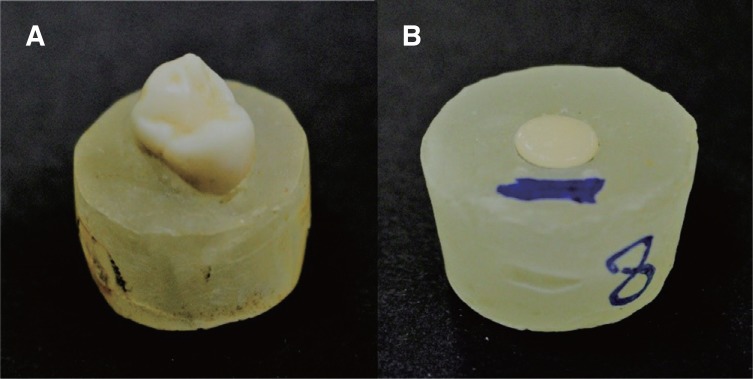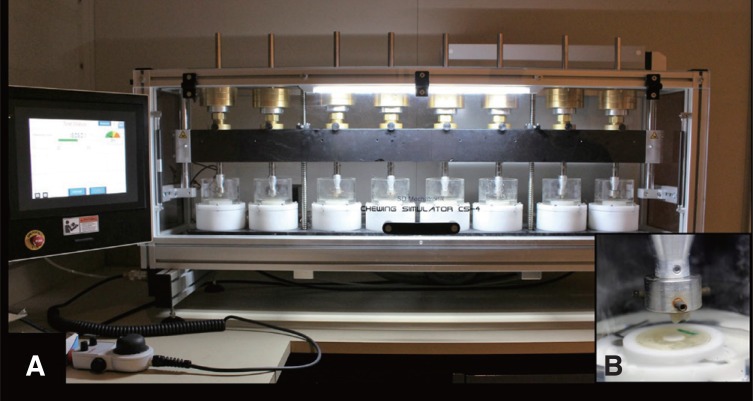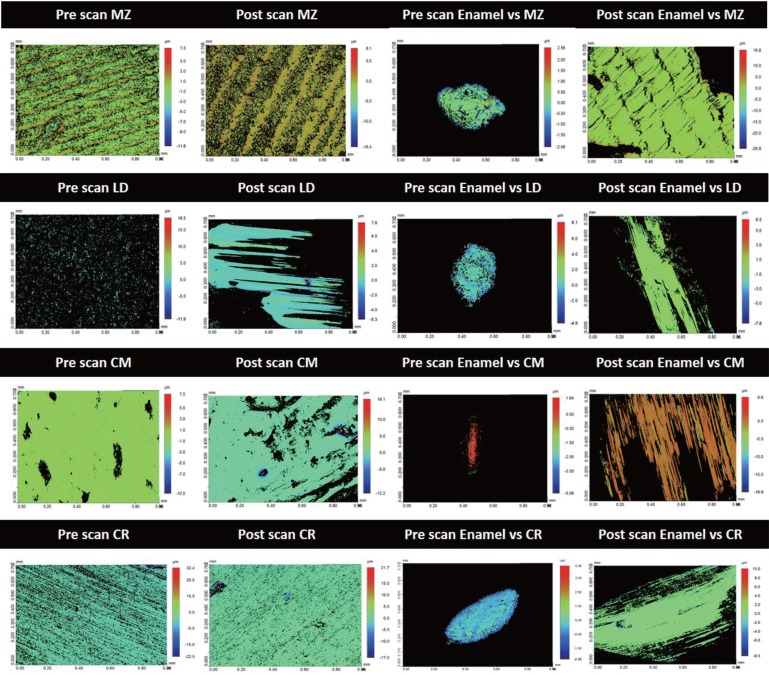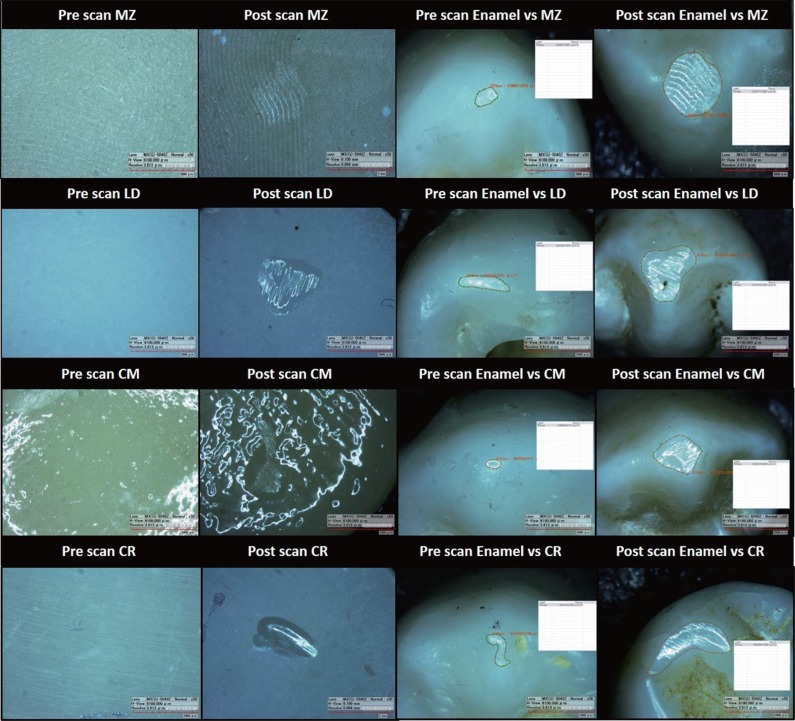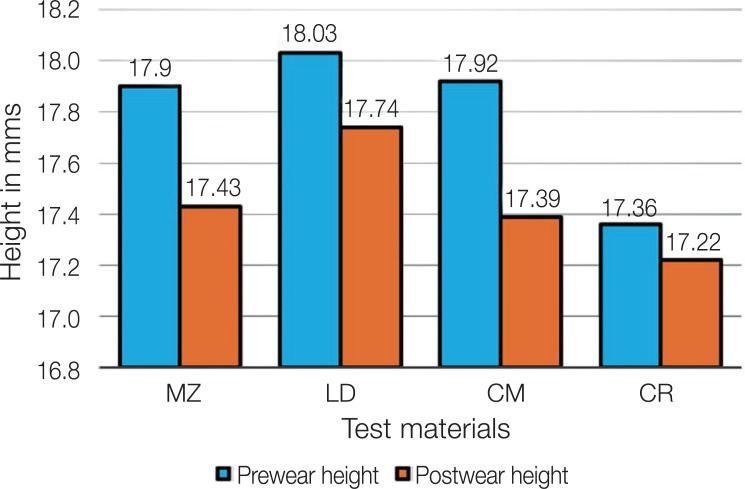J Adv Prosthodont.
2019 Feb;11(1):23-31. 10.4047/jap.2019.11.1.23.
Two-body wear behavior of human enamel versus monolithic zirconia, lithium disilicate, ceramometal and composite resin
- Affiliations
-
- 1Department of Prosthetic Dental Sciences, College of Dentistry, King Saud University, Riyadh, Saudi Arabia. rashidhabib@hotmail.com
- 2College of Dentistry, King Saud University, Riyadh, Saudi Arabia.
- KMID: 2438928
- DOI: http://doi.org/10.4047/jap.2019.11.1.23
Abstract
- PURPOSE
To investigate and compare the surface roughness (SR), weight and height of monolithic zirconia (MZ), ceramometal (CM), lithium disilicate glass ceramic (LD), composite resin (CR), and their antagonistic human teeth enamel.
MATERIALS AND METHODS
32 disc shaped specimens for the four test materials (n=8) and 32 premolars were prepared and randomly divided. SR, weight and height of the materials and the antagonist enamel were recorded before and after subjecting the specimens to 240,000 wear-cycles (49 N/0.8 Hz/5℃/50℃). SR, height, weight, and digital microscopic qualitative evaluation were measured.
RESULTS
CM (0.23 + 0.08 µm) and LD (0.68 + 0.16 µm) exhibited the least and highest mean difference in the SR, respectively. ANOVA revealed significance (P=.001) between the materials for the SR. Paired T-Test showed significance (P < .05) for the pre- and post-SR for all the materials. For the antagonistic enamel, no significance (P=.987) was found between the groups. However, the pre- and post-SR values of all the enamel groups were significant (P < .05). Wear cycles had significant effect on enamel weight loss against all the materials (P < .05). CR and MZ showed the lowest and highest height loss of 0.14 mm and 0.46 mm, respectively.
CONCLUSION
MZ and CM are more resistant to SR against the enamel than LD and CR. Enamel worn against test materials showed similar SR. Significant variations in SR values for the tested materials (MZ, LD, CM, and CR) against the enamel were found. Wear simulation significantly affected the enamel weight loss against all the materials, and enamel antagonist against MZ and CM showed more height loss.
Keyword
MeSH Terms
Figure
Reference
-
1. Lucas PW, Omar R, Al-Fadhalah K, Almusallam AS, Henry AG, Michael S, Thai LA, Watzke J, Strait DS, Atkins AG. Mechanisms and causes of wear in tooth enamel: implications for hominin diets. J R Soc Interface. 2013; 10:20120923. PMID: 23303220.
Article2. Xia J, Zheng J, Huang D, Tian ZR, Chen L, Zhou Z, Ungar PS, Qian L. New model to explain tooth wear with implications for microwear formation and diet reconstruction. Proc Natl Acad Sci USA. 2015; 112:10669–10672. PMID: 26240350.
Article3. Mundhe K, Jain V, Pruthi G, Shah N. Clinical study to evaluate the wear of natural enamel antagonist to zirconia and metal ceramic crowns. J Prosthet Dent. 2015; 114:358–363. PMID: 25985742.
Article4. Clelland NL, Agarwala V, Knobloch LA, Seghi RR. Wear of enamel opposing low-fusing and conventional ceramic restorative materials. J Prosthodont. 2001; 10:8–15. PMID: 11406790.
Article5. Heintze SD, Cavalleri A, Forjanic M, Zellweger G, Rousson V. Wear of ceramic and antagonist-a systematic evaluation of influencing factors in vitro. Dent Mater. 2008; 24:433–449. PMID: 17720238.6. Wang L, Liu Y, Si W, Feng H, Tao Y, Ma Z. Friction and wear behaviors of dental ceramics against natural tooth enamel. J Eur Ceram Soc. 2012; 32:2599–2606.
Article7. Sripetchdanond J, Leevailoj C. Wear of human enamel opposing monolithic zirconia, glass ceramic, and composite resin: an in vitro study. J Prosthet Dent. 2014; 112:1141–1150. PMID: 24980740.8. Zandparsa R, El Huni RM, Hirayama H, Johnson MI. Effect of different dental ceramic systems on the wear of human enamel: An in vitro study. J Prosthet Dent. 2016; 115:230–237. PMID: 26548885.9. Shimane T, Endo K, Zheng JH, Yanagi T, Ohno H. Wear of opposing teeth by posterior composite resins-evaluation of newly developed wear test methods. Dent Mater J. 2010; 29:713–720. PMID: 21099153.10. Yesil ZD, Alapati S, Johnston W, Seghi RR. Evaluation of the wear resistance of new nanocomposite resin restorative materials. J Prosthet Dent. 2008; 99:435–443. PMID: 18514665.
Article11. Bartlett D, Varma S. A retrospective audit of the outcome of composites used to restore worn teeth. Br Dent J. 2017; 223:33–36. PMID: 28684832.
Article12. Borgia E, Baron R, Borgia JL. Quality and survival of direct light-activated composite resin restorations in posterior teeth: A 5- to 20-year retrospective longitudinal study. J Prosthodont. 2017; 5. 17.
Article13. Ho TK, Satterthwaite JD, Silikas N. The effect of chewing simulation on surface roughness of resin composite when opposed by zirconia ceramic and lithium disilicate ceramic. Dent Mater. 2018; 34:e15–e24. PMID: 29175160.
Article14. Denry I, Holloway JA. Ceramics for dental applications: A review. Materials. 2010; 3:351–368.
Article15. Araujo NS, Moda MD, Silva EA, Zavanelli AC, Mazaro JV, Pellizzer EP. Survival of all-ceramic restorations after a minimum follow-up of five years: A systematic review. Quintessence Int. 2016; 47:395–405. PMID: 26949760.16. Ren L, Zhang Y. Sliding contact fracture of dental ceramics: Principles and validation. Acta Biomater. 2014; 10:3243–3253. PMID: 24632538.
Article17. Arsecularatne JA, Chung NR, Hoffman M. An in vitro study of the wear behaviour of dental composites. Biosurf Biotribol. 2016; 2:102–113.18. Zhao X, Pan J, Zhang S, Malmstrom HS, Ren YF. Effectiveness of resin-based materials against erosive and abrasive enamel wear. Clin Oral Investig. 2017; 21:463–468.
Article19. Fischer TE, Anderson MP, Jahanmir S. Influence of fracture toughness on the wear resistance of yttria-doped zirconium oxide. J Am Ceram Soc. 1989; 72:252–257.
Article20. Mitov G, Heintze SD, Walz S, Woll K, Muecklich F, Pospiech P. Wear behavior of dental Y-TZP ceramic against natural enamel after different finishing procedures. Dent Mater. 2012; 28:909–918. PMID: 22608163.
Article21. Mörmann WH, Stawarczyk B, Ender A, Sener B, Attin T, Mehl A. Wear characteristics of current aesthetic dental restorative CAD/CAM materials: two-body wear, gloss retention, roughness and Martens hardness. J Mech Behav Biomed Mater. 2013; 20:113–125. PMID: 23455168.
Article22. Rosentritt M, Preis V, Behr M, Hahnel S, Handel G, Kolbeck C. Two-body wear of dental porcelain and substructure oxide ceramics. Clin Oral Investig. 2012; 16:935–943.
Article23. Stawarczyk B, Özcan M, Schmutz F, Trottmann A, Roos M, Hämmerle CH. Two-body wear of monolithic, veneered and glazed zirconia and their corresponding enamel antagonists. Acta Odontol Scand. 2013; 71:102–112. PMID: 22364372.
Article24. Stawarczyk B, Frevert K, Ender A, Roos M, Sener B, Wimmer T. Comparison of four monolithic zirconia materials with conventional ones: Contrast ratio, grain size, four-point flexural strength and two-body wear. J Mech Behav Biomed Mater. 2016; 59:128–138. PMID: 26751707.
Article25. Mitov G, Heintze SD, Walz S, Woll K, Muecklich F, Pospiech P. Wear behavior of dental Y-TZP ceramic against natural enamel after different finishing procedures. Dent Mater. 2012; 28:909–918. PMID: 22608163.
Article26. Janyavula S, Lawson N, Cakir D, Beck P, Ramp LC, Burgess JO. The wear of polished and glazed zirconia against enamel. J Prosthet Dent. 2013; 109:22–29. PMID: 23328193.
Article27. Heintze SD. How to qualify and validate wear simulation devices and methods. Dent Mater. 2006; 22:712–734. PMID: 16574212.
Article28. Preis V, Behr M, Kolbeck C, Hahnel S, Handel G, Rosentritt M. Wear performance of substructure ceramics and veneering porcelains. Dent Mater. 2011; 27:796–804. PMID: 21524788.
Article29. Rosentritt M, Behr M, van der, Feilzer AJ. Approach for valuating the influence of laboratory simulation. Dent Mater. 2009; 25:348–352. PMID: 18829097.
Article30. Hahnel S, Behr M, Handel G, Rosentritt M. Two-body wear of artificial acrylic and composite resin teeth in relation to antagonist material. J Prosthet Dent. 2009; 101:269–278. PMID: 19328280.
Article31. Etman MK, Woolford M, Dunne S. Quantitative measurement of tooth and ceramic wear: in vivo study. Int J Prosthodont. 2008; 21:245–252. PMID: 18548965.32. Esquivel-Upshaw J, Rose W, Oliveira E, Yang M, Clark AE, Anusavice K. Randomized, controlled clinical trial of bilayer ceramic and metal-ceramic crown performance. J Prosthodont. 2013; 22:166–173. PMID: 22978697.
Article33. Passos SP, Torrealba Y, Major P, Linke B, Flores-Mir C, Nychka JA. in vitro wear behavior of zirconia opposing enamel: a systematic review. J Prosthodont. 2014; 23:593–601. PMID: 24957813.34. Lohbauer U, Reich S. Antagonist wear of monolithic zirconia crowns after 2 years. Clin Oral Investig. 2017; 21:1165–1172.35. Chun KJ, Lee JY. Comparative study of mechanical properties of dental restorative materials and dental hard tissues in compressive loads. J Dent Biomech. 2014; 5:1758736014555246. PMID: 25352921.
Article36. Hmaidouch R, Weigl P. Tooth wear against ceramic crowns in posterior region: a systematic literature review. Int J Oral Sci. 2013; 5:183–190. PMID: 24136675.
Article
- Full Text Links
- Actions
-
Cited
- CITED
-
- Close
- Share
- Similar articles
-
- 3D quantitative analysis and SEM qualitative analysis of natural antagonist enamel opposing CAD-CAM monolithic zirconia or lithium disilicate tooth-supported crowns versus enamel opposing natural enamel
- Effect of adhesive luting on the fracture resistance of zirconia compared to that of composite resin and lithium disilicate glass ceramic
- In vitro study of the fracture resistance of monolithic lithium disilicate, monolithic zirconia, and lithium disilicate pressed on zirconia for three-unit fixed dental prostheses
- Clinical Evaluation of Lithium Disilicate Pressed Zirconia and Monolithic Zirconia in Posterior Implant-Supported Prostheses
- Comparative analysis of transmittance for different types of commercially available zirconia and lithium disilicate materials

